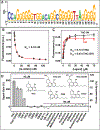Isolation of Natural DNA Aptamers for Challenging Small-Molecule Targets, Cannabinoids
- PMID: 33528997
- PMCID: PMC7895305
- DOI: 10.1021/acs.analchem.0c04592
Isolation of Natural DNA Aptamers for Challenging Small-Molecule Targets, Cannabinoids
Abstract
Aptamers are nucleic acid-based affinity reagents that are isolated via an in vitro process known as systematic evolution of ligands by exponential enrichment (SELEX). Despite their great potential for a wide range of analytical applications, there are relatively few high-quality small-molecule binding aptamers, especially for "challenging" targets that have low water solubility and/or limited moieties for aptamer recognition. The use of libraries containing chemically modified bases may improve the outcome of some SELEX experiments, but this approach is costly and yields inconsistent results. Here, we demonstrate that a thoughtfully designed SELEX procedure with natural DNA libraries can isolate aptamers with high affinity and specificity for challenging small molecules, including targets for which such selections have previously failed. We first isolate a DNA aptamer with nanomolar affinity and high specificity for (-)-trans-Δ9-tetrahydrocannabinol (THC), a target previously thought to be unsuitable for SELEX with natural DNA libraries. We subsequently isolate aptamers that exhibit high affinity and cross-reactivity to two other challenging targets, synthetic cannabinoids UR-144 and XLR-11, while maintaining excellent specificity against a wide range of non-target interferents. Our findings demonstrate that natural nucleic acid libraries can yield high-quality aptamers for small-molecule targets, and we outline a robust workflow for isolating other such aptamers in future selection efforts.
Conflict of interest statement
The authors declare no competing financial interest.
Figures



Similar articles
-
An improved SELEX technique for selection of DNA aptamers binding to M-type 11 of Streptococcus pyogenes.Methods. 2016 Mar 15;97:51-7. doi: 10.1016/j.ymeth.2015.12.005. Epub 2015 Dec 8. Methods. 2016. PMID: 26678795
-
A Capture-SELEX Strategy for Multiplexed Selection of RNA Aptamers Against Small Molecules.Methods Mol Biol. 2018;1671:291-306. doi: 10.1007/978-1-4939-7295-1_18. Methods Mol Biol. 2018. PMID: 29170966
-
Rapid Nuclease-Assisted Selection of High-Affinity Small-Molecule Aptamers.J Am Chem Soc. 2024 Aug 7;146(31):21296-21307. doi: 10.1021/jacs.4c00748. Epub 2024 Jul 23. J Am Chem Soc. 2024. PMID: 39042584
-
In vitro evolution of chemically-modified nucleic acid aptamers: Pros and cons, and comprehensive selection strategies.RNA Biol. 2016 Dec;13(12):1232-1245. doi: 10.1080/15476286.2016.1236173. Epub 2016 Oct 7. RNA Biol. 2016. PMID: 27715478 Free PMC article. Review.
-
Aptamers from random sequence space: Accomplishments, gaps and future considerations.Anal Chim Acta. 2022 Mar 1;1196:339511. doi: 10.1016/j.aca.2022.339511. Epub 2022 Jan 18. Anal Chim Acta. 2022. PMID: 35151405 Review.
Cited by
-
Examining the Relationship between Aptamer Complexity and Molecular Discrimination of a Low-Epitope Target.ACS Cent Sci. 2024 Nov 11;10(12):2213-2228. doi: 10.1021/acscentsci.4c01377. eCollection 2024 Dec 25. ACS Cent Sci. 2024. PMID: 39735321 Free PMC article.
-
Systematic bio-fabrication of aptamers and their applications in engineering biology.Syst Microbiol Biomanuf. 2023;3(2):223-245. doi: 10.1007/s43393-022-00140-5. Epub 2022 Oct 10. Syst Microbiol Biomanuf. 2023. PMID: 38013802 Free PMC article. Review.
-
High-Performance Cannabinoid Sensor Empowered by Plant Hormone Receptors and Antifouling Magnetic Nanorods.ACS Sens. 2023 Oct 27;8(10):3914-3922. doi: 10.1021/acssensors.3c01488. Epub 2023 Sep 22. ACS Sens. 2023. PMID: 37737572 Free PMC article.
-
Isolation and Characterization of a ssDNA Aptamer against Major Soluble Antigen of Renibacterium salmoninarum.Molecules. 2022 Mar 12;27(6):1853. doi: 10.3390/molecules27061853. Molecules. 2022. PMID: 35335217 Free PMC article.
-
A Label-Free Colorimetric Aptasensor for Flavokavain B Detection.Sensors (Basel). 2025 Jan 19;25(2):569. doi: 10.3390/s25020569. Sensors (Basel). 2025. PMID: 39860936 Free PMC article.
References
Publication types
MeSH terms
Substances
Grants and funding
LinkOut - more resources
Full Text Sources
Other Literature Sources

